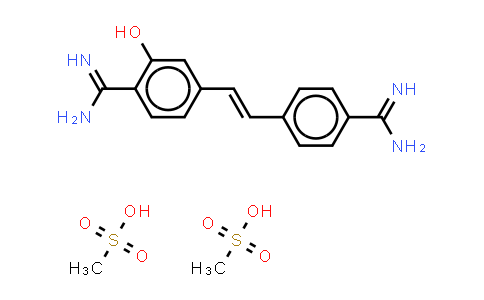
Hydroxystilbamidine bis(methanesulfonate) NLT 98%
Product Number : MC542312
CAS Number : 223769-64-0
Molecular Formula : C18H24N4O7S2 | Molecular Weight : 472.54
Quote Request| Purity | NLT 98% |
|---|---|
| Storage | at 20ºC 2 years |
| MolCore specializes in manufacturing high-purity CAS No.223769-64-0, Hydroxystilbamidine bis(methanesulfonate) with the molecular formula C18H24N4O7S2 and molecular weight 472.54 delivering critical API intermediates for global pharmaceutical and research industries, certified under ISO quality systems. | |
* The above information is for reference only.
| Chemical Name | Hydroxystilbamidine bis(methanesulfonate) |
|---|---|
| CAS Number | 223769-64-0 |
| MDL Number | MFCD01863083 |
| Molecular Formula | C18H24N4O7S2 |
| Molecular Weight | 472.54 |
Hydroxystilbamidine bis(methanesulfonate), a dye capable of binding to both DNA and RNA, has been found to be a powerful inhibitor of cellular ribonucleases. In Vitro: It is found that the trypanocidal dye Hydroxystilbamidine bis(methanesulfonate) permits the recovery of mRNA after polysome released with Nonidet P-40 (NP-40). Sucrose gradient analysis of detergent-lysed postnuclear supernates is used to analyze the size distribution of NP-40-released polysomes. The heparin gradient shows some polyribosomes, whereas the Hydroxystilbamidine bis(methanesulfonate) gradient shows a remarkably large peak of very heavy polyribosomes. This peak is obtained reproducibly if Hydroxystilbamidine bis(methanesulfonate) is present before the addition of NP-40[1]. In Vivo: Hydroxystilbamidine bis(methanesulfonate) is an effective suppressor of the plaque-forming cell (PFC) response when given before sheep erythrocytes (SRBC) stimulation. Hydroxystilbamidine bis(methanesulfonate) depresses the plaque response of the treated mice. Fewer PFC are observed in Hydroxystilbamidine bis(methanesulfonate)-treated mice throughout the experiment, but the level of suppression decreases with time. By day 14, the number of PFC observed in both the Hydroxystilbamidine bis(methanesulfonate) treated mice and the control group is essentially at the background level[2].
© Copyright 2015-2025 Hangzhou MolCore BioPharmatech Co.,Ltd. All rights reserved.
